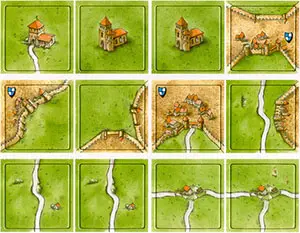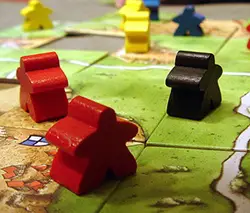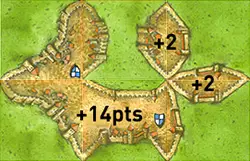

Game Components
70 Land tiles showing roads, cities, fields and monasteries. There is one start tile with a darker back.
The 12 river tiles are not part of the basic game but have the same back as the start tile.
- 40 followers in 5 colors.
Each player will use one of their followers as a score marker. - One scoreboard.
- One rulebook and 1 player aid.
Setup
The start tile is placed in the center of the table, while the scoreboard is placed on the edge of the table.
The other tiles are shuffled and placed on a face-down stack.
Each player takes his 8 followers (of his color) and puts one of them on the scoreboard (on number zero).
Now the players decide who can start the game.
Game Play
On their turn, a player can do the following actions in the following order:
- Draw and place one new land tile.
- A player can choose if he want to put one follower from his supply on the just placed tile.
- When by placing a tile one or more roads, cities or monasteries are completed, then points will be received immediately.
- Return possible thieves, knights or monks to their supply.
The player's turn is now over and the next player (clockwise) can start his turn.
Tutorial Video
Placing Land Tiles

A player draws one tile of the face-down land tiles. He must place that tile on the table according the following rules:
The new tile must be placed with at least one edge abutting one previously placed tile. The new tile cannot only be connected by a corner with a previous tile.
The new tile must be placed so that all road, city and field segments on the new tile match road, city or field segments on all abutting tiles (cloisters are always complete within single tiles)
In the rare circumstances where a drawn tile cannot be placed, the player returns the tile to the box and draws another tile.
Placing New Followers

After a player placed a tile, he may deploy one of his followers, using the following rules:
- The player may only place one follower on a turn.
- The player must take it from his supply.
- The player may only put it on the tile he just placed.
- The player must choose where to deploy the follower on the tile: thief on a road, knight in a city, monk in a cloister or farmer in a field.
- The player may not place her follower on a road, in a city or in a field if that section is connected to another tile where there already is a follower.
When a player has deployed all his followers, he continues to play tiles each turn.
A player is never allowed to retake one of his followers from a tile, although they are returned when roads, cities or monasteries are finished.
Then, the player's turn is over. After, in clockwise order, the next player takes his turn, followed by the next one, etc.
Note: If after placing a tile something get completed, it's immediately scored before the next player's turn.
Scoring

When a player scores points, he moves the scoring marker forward on the scoring track the number of spaces equal to the points earned.
If the scoring marker goes beyond 50, put the marker on its side to indicate that you now have more than 50 points.
-
A completed road

A road is complete once both ends of the road are connected to a crossroad, a city section, a monastery or the road loops onto itself. There may be many segments along the road.
The player who has a thief on a completed road scores 1 point per tile used in completed the road.
-
A completeted city

A city is complete when it is completely surrounded by walls and there are no gaps in the walls. There may be many segments in a city.
A player who owns a knight in a completed city scores 2 points per tile used in the city. Each shield or banner in the city gives the player 2 bonus points.
Note: When a completed road or city has more than one follower, then the player with the most thieves or knights scores all the points. In case of the tie, they both scores the points.
-
A completed monastery

A monastery or cloister is complete when the tile it is on is completely surrounded by tiles. The player who owns a monk in a completed monastery or cloister gets 9 points.
After completing a road, city or a monastery the followers used in the scoring are returned to their player's supply and can be used again on other tiles later.
Farms
Connected fields are called farms and they don't score during the game. Farms are bordered by roads, cities and the edge of the area where the tiles have been played.
You can deploy followers on them and they become farmers which scores in the final scoring.
So, farmers stay for the entire game on the fields and are never returned.
Final scoring
When a player places the last tile, the game will end after his turn and the final scoring takes place.
Incomplete cities, roads or monasteries
During the final scoring, incomplete roads, cities or monasteries are scored.
The player who has a thief on the road or a knight in the city scores one point for each road or city segment in the incomplete road or city. Banners or shields earn the city player one point each.
A player who has a follower on an incomplete monastery scores 1 point for each monastery tile.
Scoring farmers
Farmers score points as shown below:
- Only completed cities are counted.
- The farmer must be in a field that touches one or more completed cities. The distance of the farmer from the city is unimportant.
- For each city that the field touches, the player with the most farmers in that field scores 3 points.
- Several farms can supply a single city. Then the player with the most farmers in the farms supplying the city scores the points. If two or more players tie with the most farmers, each of those tied for most scores.

End of the game
Once all the fields have been scored, the final scoring and the game are over.
The player with the most points at the end of the game is the winner!
Continue Reading


